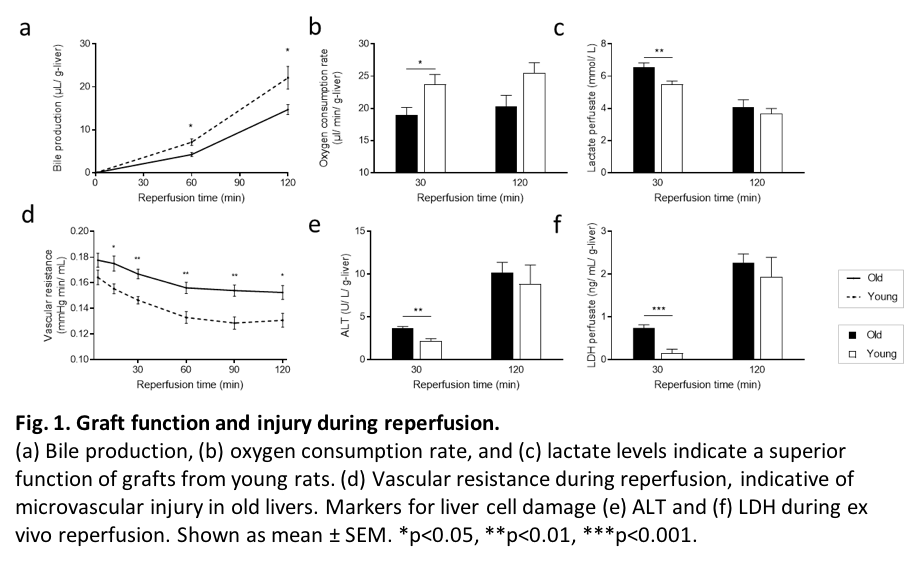Damage-Associated Molecular Pattern Release and Toll-Like Receptor Activation during Cold Storage and Ex Vivo Reperfusion of Old Rat Livers
Department of Surgery, Duke University Medical Center, Durham, NC
Meeting: 2019 American Transplant Congress
Abstract number: B14
Keywords: Age factors, Graft function, Inflammation, Liver grafts
Session Information
Session Name: Poster Session B: Ischemia Reperfusion & Organ Rehabilition
Session Type: Poster Session
Date: Sunday, June 2, 2019
Session Time: 6:00pm-7:00pm
 Presentation Time: 6:00pm-7:00pm
Presentation Time: 6:00pm-7:00pm
Location: Hall C & D
*Purpose: Donor age is one of the most important predictive factors of graft outcome in liver transplantation. The aim of this study was to investigate the influence of donor age on cold storage injury and early graft function in a rat model.
*Methods: The experimental groups consisted of livers retrieved from old (mean age: 26 months, n = 7) versus young (mean age: 2.5 months, n = 7) male Lewis rats. Livers were preserved by static cold storage for 12 hours, and then reperfused ex vivo at 37°C for 2 hours using Krebs-Henseleit buffer. Graft injury during cold storage was determined by measurement of damage-associated molecular patterns (DAMPs) in cold storage solution. During graft reperfusion, parameters of graft function and injury were measured.
*Results: Older grafts demonstrated significantly greater injury during cold storage, with greater release of HMGB1 and exDNA. During early reperfusion, older grafts demonstrated increased injury and impaired function compared to young grafts (Fig. 1). Older grafts showed evidence of energy depletion, with lower ATP/ADP ratios after reperfusion. Interestingly, after 2 hours of reperfusion, younger grafts demonstrated a more robust release of inflammatory molecules, leading to increased activation of Toll-like receptors (TLR) 3 and 9 and greater IL-1α release (Fig. 2).
*Conclusions: Older grafts experience greater injury during cold storage compared to young grafts. During reperfusion, older grafts exhibit decreased function while younger grafts produce a more robust inflammatory response.
To cite this abstract in AMA style:
Scheuermann U, Seyferth ER, Zhu M, Song M, Yerxa J, Davis RP, Parker W, Hartwig M, Kwun J, Lee J, Barbas AS. Damage-Associated Molecular Pattern Release and Toll-Like Receptor Activation during Cold Storage and Ex Vivo Reperfusion of Old Rat Livers [abstract]. Am J Transplant. 2019; 19 (suppl 3). https://atcmeetingabstracts.com/abstract/damage-associated-molecular-pattern-release-and-toll-like-receptor-activation-during-cold-storage-and-ex-vivo-reperfusion-of-old-rat-livers/. Accessed July 9, 2025.« Back to 2019 American Transplant Congress


